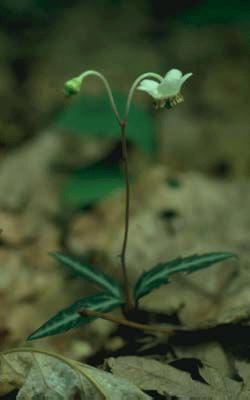James L. Luteyn and Paola Pedraza-Peñalosa
The New York Botanical Garden
 |
Chimaphila (Ericaceae: Pyroloideae)
is a well-marked genus of five species that are found in boreal and temperate
North America, Europe, and Asia; two species are disjunct in the
mountains of Mexico and Central America, one extending south to Panama
and the other to Guatemala. A subspecies of the latter is endemic
to Hispaniola. |
The
two species of Chimaphila that occur in the Flora Neotropica area
clearly represent boreal and temperate elements that are disjunct in the
mountains of Mexico, Central America, and Hispaniola.
Pursh (1814) initiated the break-up of the
Linnaean genus Pyrola when he segregated P. umbellata Linnaeus
and P. maculata Linnaeus as the genus Chimaphila. All
subsequent workers have accepted this segregate. A revision of the
genus appears warranted and undoubtedly would improve Andres' (1913, 1914a)
sectional classification.
CHIMAPHILA Pursh, Fl. amer. sept. 1: 279. 1814. Chimophila Radius, Pyrola & Chimaphila 7, 33.
1821, orth. var. Pyrola Linnaeus sect. Chimaphila (Pursh)
J. E. Smith in Rees, Cycl. 29 (I, 57). 1814. Pyrola Linnaeus subgen. Chimaphila (Pursh) Rafinesque, Med. fl. 2: 71.
1830; Dorr, Fl. Neotro. Monogr. 66: 37-45. 1995. Lectotype
designated by Britton & Brown, 1913: Chimaphila maculata (Linnaeus)
Pursh.
[Pseva Rafinesque, Amer. Monthly Mag. Crit. Rev. 2(4): 266. 1818; Rafinesque, J. Phys. Chim. Hist. Nat. Arts 89: 261. 1819, nom. nud., pro syn.]Pyrola Linnaeus subgen. Psiseva Rafinesque, Med. Fl. 2: 70. 1830. Type: Pyrola umbellata Linnaeus (=Chimaphila umbellata (Linnaeus) W. P. C. Barton).
[Pipseva Rafinesque, Autik. bot. 105. 1840, nom. illeg. Type: Pipseva officinalis Rafinesque (=Pyrola umbellata Linnaeus = Chimaphila umbellata (Linnaeus) W. P. C. Barton).]
Subshrubs, erect (rarely decumbent), to
5.3 dm tall, stems simple or branched at the base. Leaves alternate
to subopposite, clustered in 2-5(-6) pseudo-whorls along the stem, the
pseudo-whorls often separated by conspicuous internodes; leaf blades
slightly revolute, coriaceous, often shiny or lustrous; margin toothed
or serrate. Inflorescences stalked corymbs, subumbels, or rarely
flowers solitary; peduncles and pedicels finely papillate or smooth;
each flower subtended by a deciduous or persistent bract. Flowers
fragrant, nodding to divergent; calyx persistent in fruit;
corolla crateriform to broadly crateriform, actinomorphic, the petals concave,
broadly-ovate to obovate, thick, white, pink, or rose-pink, spreading to
reflexed, without appendages or
tubercles; stamens included; filaments dilated basally,
the dilated portion ciliate, ciliolate, villous, or glabrous; anther
thecae wrinkled, papillate or smooth, terminated by anther tubes 0.5-1
mm long, diverging, pores ovate; ovary subtended by a 5-angled, nectariferous
disc; style very short or subsessile, obconical or turbinate, depressed
in the summit of the ovary; stigma peltate, rounded, entire or with
5 undulate lobes. Fruit a depressed-globose capsule, erect, borne
on an erect pedicel, brown or dark-brown, dehiscence complete, the
argins of the valves smooth; seeds light golden-brown, the testa
evidently without pits. Chromosome number: n=13.
Key to Neotropical Species Back to Top
1. Leaf blades lanceolate to ovate-lanceolate, usually marked
with white above
on midribs and larger secondary veins (i.e.,
maculated), base obtuse, rounded,
or widely cuneate, margins distantly serrate,
teeth occurring the length of
the margins; dilated portion of the
filaments villous ............................. C.
maculata.
1. Leaf blades oblanceolate or spatulate to elliptic, uniformly
green above,
base cuneate, margins finely serrate, teeth
often restricted to the upper
margins; dilated portion of the filaments
glabrous or merely papillate on
the margins ..................................................................................... C. umbellata.
This is an modified version of the taxonomic treatment of the neotropical species of Chimaphila (Ericaceae: Pyroloideae) by Laurence J. Dorr, from "Ericaceae--Part II. The Superior-Ovaried Genera (Monotropoideae, Pyroloideae, Rhododendroideae, and Vaccinioideae p.p.)." The full treatment including specimen citations may be see in Flora Neotropica Monograph 66: 37-46 (Dorr, 1995b). This on-line synthesis is published with permission of The New York Botanical Garden and Laurence J. Dorr.